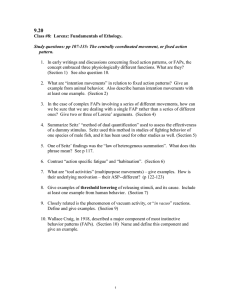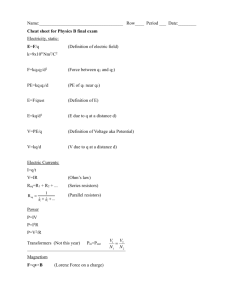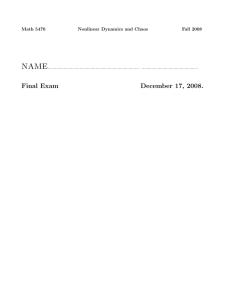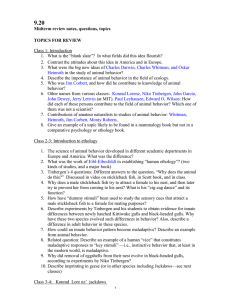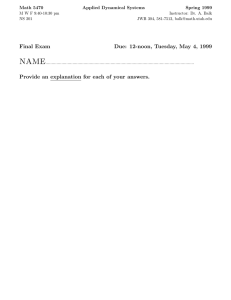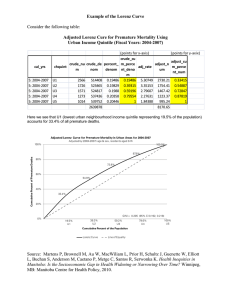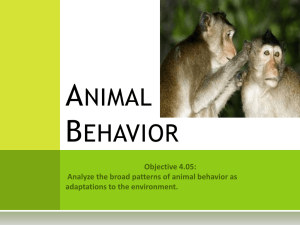Document 13504155
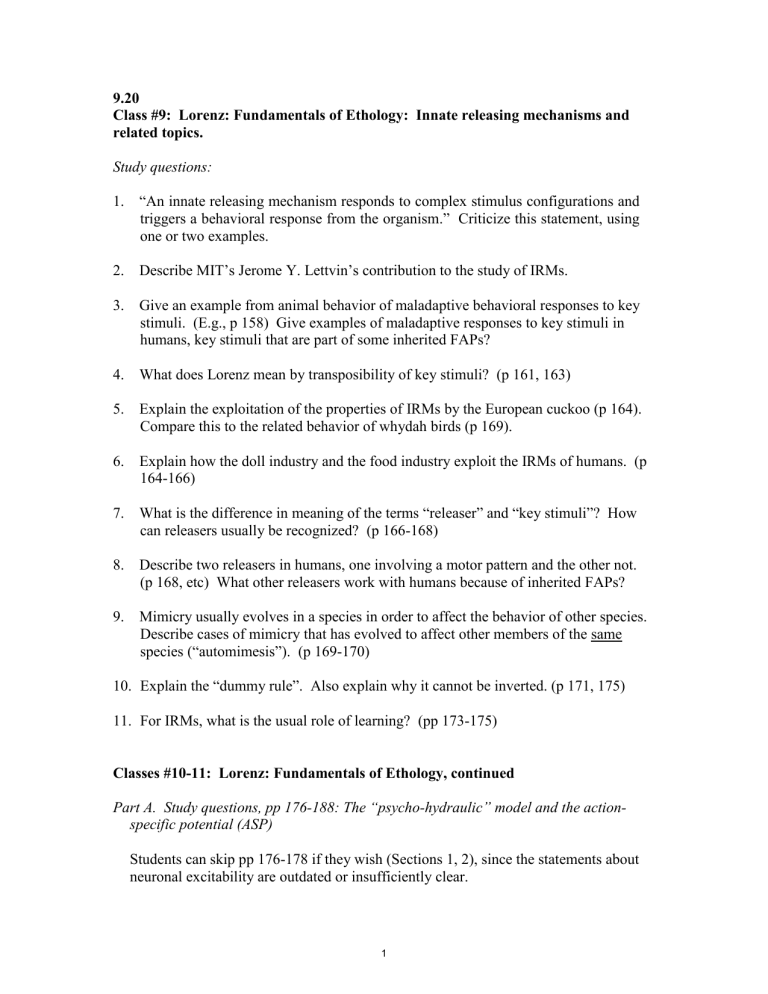
9.20
Class #9: Lorenz: Fundamentals of Ethology: Innate releasing mechanisms and related topics.
Study questions:
1. “An innate releasing mechanism responds to complex stimulus configurations and triggers a behavioral response from the organism.” Criticize this statement, using one or two examples.
2. Describe MIT’s Jerome Y. Lettvin’s contribution to the study of IRMs.
3. Give an example from animal behavior of maladaptive behavioral responses to key stimuli. (E.g., p 158) Give examples of maladaptive responses to key stimuli in humans, key stimuli that are part of some inherited FAPs?
4. What does Lorenz mean by transposibility of key stimuli? (p 161, 163)
5. Explain the exploitation of the properties of IRMs by the European cuckoo (p 164).
Compare this to the related behavior of whydah birds (p 169).
6. Explain how the doll industry and the food industry exploit the IRMs of humans. (p
164-166)
7. What is the difference in meaning of the terms “releaser” and “key stimuli”? How can releasers usually be recognized? (p 166-168)
8. Describe two releasers in humans, one involving a motor pattern and the other not.
(p 168, etc) What other releasers work with humans because of inherited FAPs?
9. Mimicry usually evolves in a species in order to affect the behavior of other species.
Describe cases of mimicry that has evolved to affect other members of the same species (“automimesis”). (p 169-170)
10. Explain the “dummy rule”. Also explain why it cannot be inverted. (p 171, 175)
11. For IRMs, what is the usual role of learning? (pp 173-175)
Classes #10-11: Lorenz: Fundamentals of Ethology, continued
Part A. Study questions, pp 176-188: The “psycho-hydraulic” model and the action- specific potential (ASP)
Students can skip pp 176-178 if they wish (Sections 1, 2), since the statements about neuronal excitability are outdated or insufficiently clear.
1
1. Explain the difference between Lorenz’ old mechanical/hydraulic model and his revised model, depicted in figures 18a and 18b.
2. The brain-stimulation work of Erich von Holst indicated a relationship between the level of the CNS stimulated and the time course of behavioral effects of the stimulation. Explain. (p 183)
3. Give examples of the effects of the “inertia of excitation” (p 184) in animal behavior, i.e., behavior that occurs after the sudden removal of the stimulus that elicits a fixed action pattern. What examples from human behavior can you think of?
4. How can we explain the fact that the urination activities of a male dog often do not depend on the amount of urine in the bladder? Upon what do they depend? (p 186)
Part B. Study questions, pp 191-210: Chains of behavior; hierarchical systems; the
“relative hierarchy of moods”
5. Describe the chain of behavior patterns shown by newborn kittens in nursing behavior. Note how an innate motor pattern acts as appetitive behavior for another innate motor pattern, in a “functionally consistent chain.” (p 192)
6. Such chains of behavior are very common, and were described by Tinbergen as examples of a “hierarchical organization of instinct.” Such a hierarchy can be depicted diagrammatically as in figures 19a and 19b (often reproduced in textbooks).
Note how Tinbergen’s diagrams show a view of IRMs and FAPs that differ from the
Lorenz model. What is the major difference?
7. What is the major point made by Lorenz in his description of Baerends’ (1956) analysis of the parental behavior of the female digger wasp? (pp 198-202)
8. What is the “upending” behavior of ducks and geese? In what abnormal circumstance would such birds be “feeding for the sake of upending instead of upending for the sake of feeding – as is usually done”? Such an example shows how motivation at one level in a hierarchy may be stronger than that from a higher level, and thus indicating some independence. (p 202)
9. In Lorenz’ view, why did the head, containing the “locus of superior command,” have to be invented in evolution? How, in general, has the function of the “head ganglion” changed in higher vertebrates, with respect to FAPs?
Part C. Study questions, pp 235-241: Taxis and reflexes; spatial orientation and thinking in higher animals
10. Explain how the “mantle of reflexes” (term from von Holst) tends to conceal the rigidity of fixed motor patterns. (pp 235-236)
11. How does a goldfish solve the problem of reaching a bit of food it can see behind an impenetrable obstacle? (p 237) It can do this without the need for learning.
12. How do human languages give clues to the nature of “insight”?
13. Describe evidence for thinking in apes, from studies of “insight” learning.
14. Note Lorenz’ hypothesis of a higher control center in “higher” animals,
“superimposed on all these orienting mechanisms” and remembering changes in the environment and judging “the priority of incoming insight information” (p 241).
How can we distinguish higher and lower animals?
Part D. Study questions, pp 242-253: Multiple motivations: compromises; ritualization.
15. Briefly list the various ways animals deal with the simultaneous activation of two (or more) motivational states. How is the conflict resolved, or not resolved?
16. Give an example of how superposition of approach and avoidance FAPs occur in geese or in fish. (p 243-244)
17. Describe evidence that gestures of threat have originated from superpositions. (p
244)
18. Mutual inhibition usually occurs between action patterns at the same level of organization (p 247), so that only one will be expressed at any one time. However, one action pattern may be given absolute priority. Explain.
19. Mutual inhibition an also cause oscillations between two FAPs. Give an example of how such oscillations can become “ritualized” in evolution, so they become social signals.
20. Define “displacement activity.” In what two situations do displacement activities occur? (p 249) You should also know the related concept of “afterdischarge displacements” (see question A3).
21. Give examples of the species-specific nature of displacement activities. (p 251-252)
22. Why do displacement activities sometimes become ritualized and undergo changes from the original FAPs they represent? (p 252-253)
3
MIT OpenCourseWare http://ocw.mit.edu
9.20 Animal Behavior
Fall 2013
For information about citing these materials or our Terms of Use, visit: http://ocw.mit.edu/terms .
